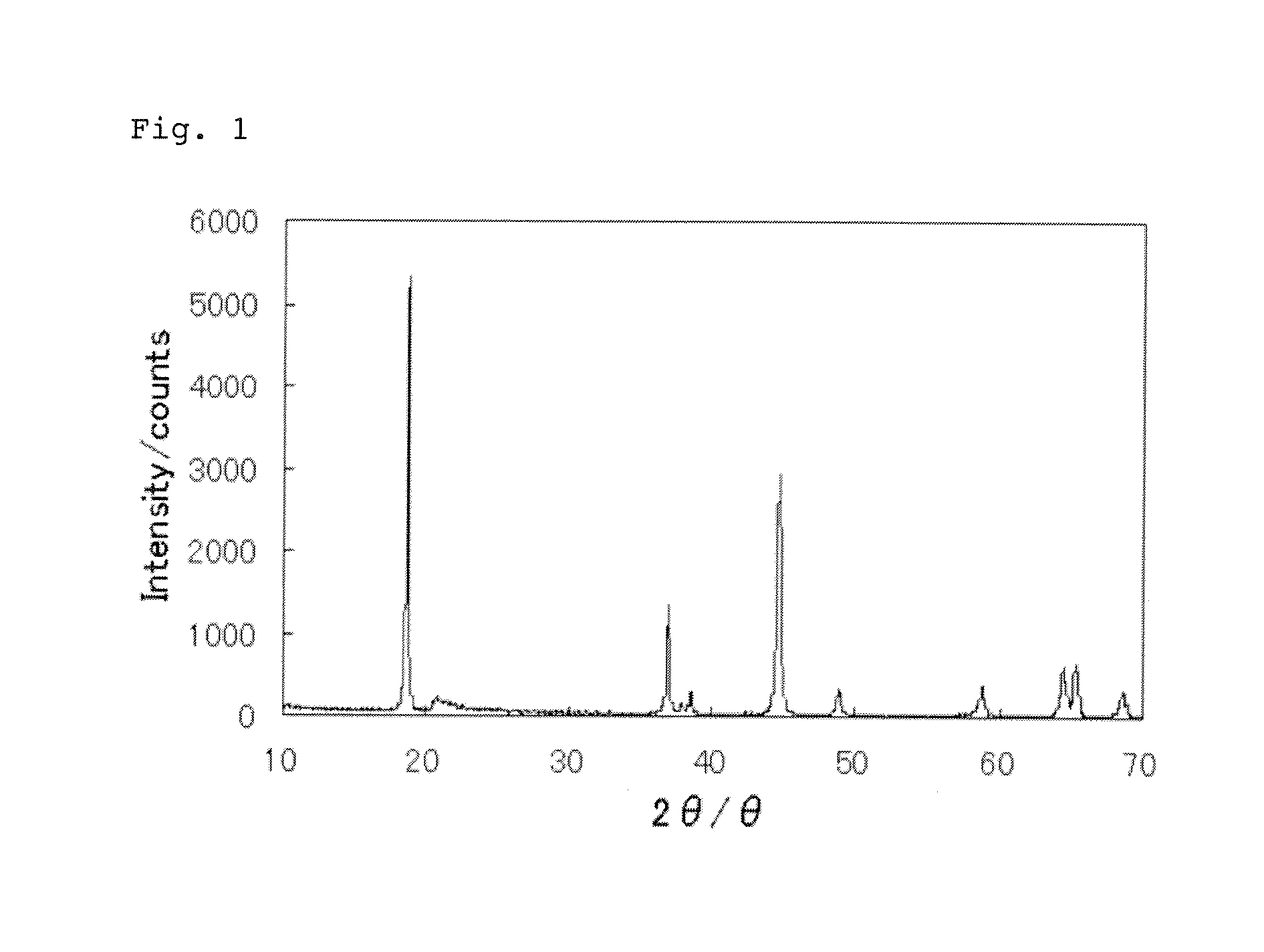Positive electrode active substance particles and process for producing the same, and non-aqueous electrolyte secondary battery
a technology of active substances and positive electrodes, which is applied in the direction of batteries, sustainable manufacturing/processing, nickel compounds, etc., can solve the problems of failure to solve the above-described conventional problems, and deterioration in thermal stability and storage characteristics of secondary batteries, etc., to achieve the effect of improving cycle characteristics and large charge/discharge capacity
- Summary
- Abstract
- Description
- Claims
- Application Information
AI Technical Summary
Benefits of technology
Problems solved by technology
Method used
Image
Examples
example 1
[0074]A sealed type reaction vessel was charged with 14 L of water, and an inside of the reaction vessel was maintained at 50° C. while flowing a nitrogen gas therethrough. Further, a 1.5 M Ni-, Co- and Mn-sulfate mixed aqueous solution, a 0.8 M sodium carbonate aqueous solution and a 2 M ammonia aqueous solution were successively added into the reaction vessel while stirring such that the pH value therein was adjusted to 8.2 (±0.2). During the reaction, a filtrate only was discharged out of the reaction system using a concentration device, whereas a solid component separated from the filtrate was retained in the reaction vessel. After the reaction was continued for 20 hr, a slurry comprising a co-precipitated product was obtained. The thus obtained slurry was filtered, and the resulting solid was washed with water and dried at 105° C. overnight, thereby obtaining a co-precipitated precursor in the form of particles.
[0075]The thus obtained co-precipitated precursor, lithium carbonat...
example 2
[0078]A sealed type reaction vessel was charged with 14 L of water, and an inside of the reaction vessel was maintained at 45° C. while flowing a nitrogen gas therethrough. Further, a 1.5 M Ni-, Co- and Mn-sulfate mixed aqueous solution, a 0.8 M sodium carbonate aqueous solution and a 2 M ammonia aqueous solution were successively added into the reaction vessel while stirring such that the pH value therein was adjusted to 8.6 (±0.2). During the reaction, a filtrate only was discharged out of the reaction system using a concentration device, whereas a solid component separated from the filtrate was retained in the reaction vessel. After the reaction was continued for 60 hr, a slurry comprising a co-precipitated product was obtained. The thus obtained slurry was filtered, and the resulting solid was washed with water and dried at 105° C. overnight, thereby obtaining a co-precipitated precursor in the form of particles.
[0079]The thus obtained co-precipitated precursor, lithium carbonat...
example 3
[0082]A sealed type reaction vessel was charged with 14 L of water, and an inside of the reaction vessel was maintained at 55° C. while flowing a nitrogen gas therethrough. Further, a 1.5 M Ni-, Co- and Mn-sulfate mixed aqueous solution, a 0.8 M sodium carbonate aqueous solution and a 2 M ammonia aqueous solution were successively added into the reaction vessel while stirring such that the pH value therein was adjusted to 8.0 (±0.2). During the reaction, a filtrate only was discharged out of the reaction system using a concentration device, whereas a solid component separated from the filtrate was retained in the reaction vessel. After the reaction was continued for 20 hr, a slurry comprising a co-precipitated product was obtained. The thus obtained slurry was filtered, and the resulting solid was washed with water and dried at 105° C. overnight, thereby obtaining a co-precipitated precursor in the form of particles.
[0083]The thus obtained co-precipitated precursor, lithium carbonat...
PUM
 Login to View More
Login to View More Abstract
Description
Claims
Application Information
 Login to View More
Login to View More - R&D
- Intellectual Property
- Life Sciences
- Materials
- Tech Scout
- Unparalleled Data Quality
- Higher Quality Content
- 60% Fewer Hallucinations
Browse by: Latest US Patents, China's latest patents, Technical Efficacy Thesaurus, Application Domain, Technology Topic, Popular Technical Reports.
© 2025 PatSnap. All rights reserved.Legal|Privacy policy|Modern Slavery Act Transparency Statement|Sitemap|About US| Contact US: help@patsnap.com

